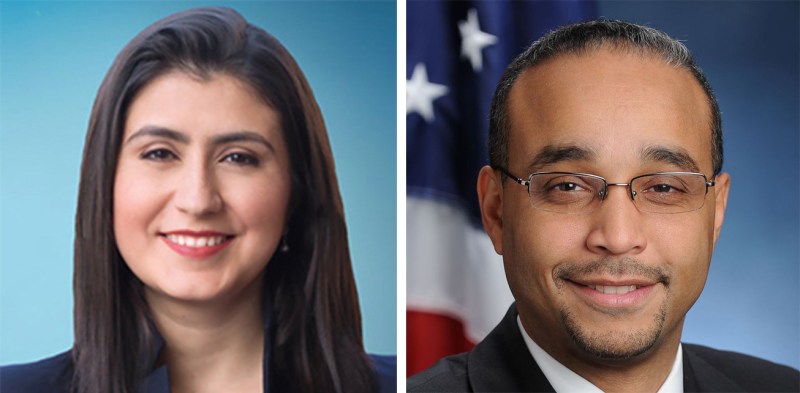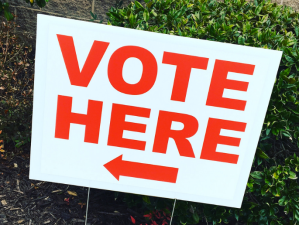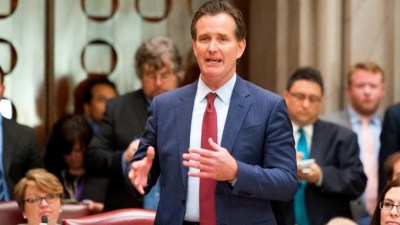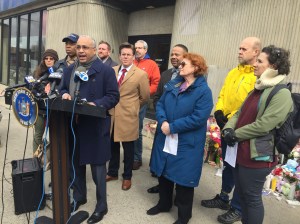State Senate District 13 Questionnaires: Jessica Ramos vs. Jose Peralta
Streetsblog pins down two Queens Democrats on the eve of their Sept. 13 primary battle.

Insurgent candidates are challenging incumbents in Albany this year like never before — and for good reason: The State Senate’s failure to pass speed camera legislation this summer, the legislature’s stall on congestion pricing, and the upper chamber’s general political dysfunction are motivating people to focus on whether Albany itself is working.
So Streetsblog asked candidates in the upcoming Democratic primaries to answer basic questions about street safety and mobility. Today we look at the 13th Senate District in Queens: Jessica Ramos against incumbent Jose Peralta. Peralta has been under fire because he was a member of the former Independent Democratic Conference, which caucused with Republicans, giving the GOP control of the Senate. In this race, StreetsPAC did not make an endorsement, despite having a track record of opposing IDC members.
Here are the candidates’ answers, unedited, with a map of the district at the bottom of this post:
Do you support congestion pricing in New York City? If so, in what form? If not, why not?
RAMOS: Yes, congestion pricing reduces the number of cars on the road. Fewer cars reduce crashes and emissions, making us all safer and healthier. I support surcharges on driving into lower Manhattan, but we need our public transportation system to be much more reliable in order to handle increased ridership. There needs to be an exemption for people with disabilities.
PERALTA: New York City’s transit system needs a major overhaul. An integral part of creating a better MTA is addressing automobile congestion through fiscal measures and engineering controls. To this end, I was one of the first state legislators to endorse the MOVE-NY plan and I continue to support a transit-related revenue lockbox. Each congestion pricing plan brought before the Legislature, including MOVE-NY, has come with significant equity concerns from outer borough automobile commuters, for-hire vehicles, freight and delivery operators, etc. That being said, almost 70 percent of my constituents rely on the subway each day, thus, congestion pricing revenues would tremendously improve the both the physical and fiscal condition of the NYC Subway system. I remain thoroughly committed to ongoing discussions with my colleagues regarding a plan that will provide the best long-term benefit for commuters and solvency of the MTA. Building on what was accomplished in the FY 2018-19 budget, I am confident we can deliver a comprehensive congestion pricing plan.
Subway ridership is down and New York’s buses are slower than ever. What will you do in Albany/are doing in Albany to fix it?

I support the Millionaire’s Tax and congestion pricing as a means to update our signal system, but I believe the MTA’s contracting practices need to be reviewed for inefficiencies. We need bus rapid transit and dedicated bus lanes.

MTA capital projects routinely cost five times as much as transit projects in other cities. How will you exert pressure on the MTA to control costs?
RAMOS: New Yorkers deserve full oversight over our public transportation system. To control costs, we need to review the MTA’s contracting practices thoroughly. I plan to use my bully pulpit, legislative power, and every tool in between to raise hell until the MTA is fixed.
How would you make streets in your district safer for walking and biking? Do you support the city’s construction of protected bike lanes? If so, why? If not, why not?
RAMOS: I support protected bike lanes and overall street redesign, especially on major thoroughfares like Northern Boulevard in my district where we’ve lost so many children to drivers who don’t yield to pedestrians, etc. I look forward to advocating for fewer cars on the road so we can make good use of our streets for everyone.
PERALTA: As a Senator and former Assemblymember, I have worked closely with NYC DOT, NYPD and other agencies on a number of street safety issues. For many years, I have been calling on NYC DOT to improve Northern Boulevard, a major thoroughfare in Queens and the 13th District. This busy road has claimed the lives of too many people, most recently nine-year-old Giovanni Ampuero, who was crossing the street while fully obeying traffic signals. Immediately following this tragic incident, I, along with other officials, walked Northern Boulevard with NYC DOT officials to further discuss concerns I have been hearing from my constituents for many years. Two specific items I have pushed for are longer crosswalk signals and safer left hand turn designs.
I am supportive of protected bike lanes, though they do not necessarily work on every road. The 111th Street bike lane has been a particular concern. Cars are regularly double-parked in bike lanes, diverting cyclists into traffic. This situation is not helped by the fact that double-parking is often under-enforced.
I do not have a civil engineering background, but my staff and I are very engaged with constituents, community boards and neighborhood groups where traffic and pedestrian safety issues are frequently discussed. Our most important role is working within the community and with government agencies to advocate for safer, more walkable streets. We have been able to get more stop signs, better traffic lights, radar-enabled signage, speed cameras and other tools to make streets safer for motorists and pedestrians alike.
What is the single biggest thing the state should do to get reckless drivers off New York City streets?
RAMOS: I believe drivers should be retested in order to weed out bad habits, like not signaling turns, and keep bad drivers off of our streets. I also believe improving our public transportation system can encourage more New Yorkers to drive less, therefore reducing congestion and road rage that has led to crashes and deaths too many times.
PERALTA: The Legislature should pass a comprehensive traffic safety package including, but not necessarily limited to:
S 336-B/A 5266-A: legislation I sponsor, which would require a 60-day suspension for any driver convicted of 2 or more school zone speeding violations within an 18-month timeframe.
S 7919/A10102, which would require suspension of a vehicle registration where such vehicle has repeatedly failed to comply with traffic control indications as documented by a photo violation monitoring device.
S7902/A10050-A, which would require reporting of certain medical conditions to the Department of Health and Department of Motor Vehicles.
I would be remiss if I did not mention the dire need for the Senate to reconvene and pass my legislation to reauthorize and expand the New York City School Zone Speed Camera Program (S6046-C). Senate Republican leadership has blocked the passage of this bill, allowing the program to expire on July 25, 2018. This is absolutely appalling.
Is there a safety, design or enforcement strategy that is not being deployed that you think is vital to making our roadways, sidewalks and public spaces work better for everyone? (Hint: This is a “visionary” question, so don’t think small.)
RAMOS: Pedestrian scrambles are underrated!
I believe we should have pedestrian scrambles outside every school during arrival and dismissal, as well as outside major transit hubs like the 74th Street station in my district.
I’m also closely monitoring Barcelona’s experiment with superblocks.
PERALTA: One of our most powerful solutions may be right under our noses. There are several fantastic community-based organizations that organize and work with officials to bring about changes (design, legal or otherwise), be it citywide or at the block level. Building upon the work of NYC DOT and these community organizations, I suggest conducting more town hall-style meetings where DOT can engage the community and integrate their needs and concerns into local transportation plans. This can be in conjunction with a specific Community Board, Neighborhood Coordination sector, Community Education Council and so on.
How often do you bike to the office (be honest)?
RAMOS: I don’t have a bike yet, but I plan to have one to ride around the district. I don’t have a driver’s license. I ride the subway or the bus to get around every day.
PERALTA: I do not bike to the office, but I do ride on the weekends.




